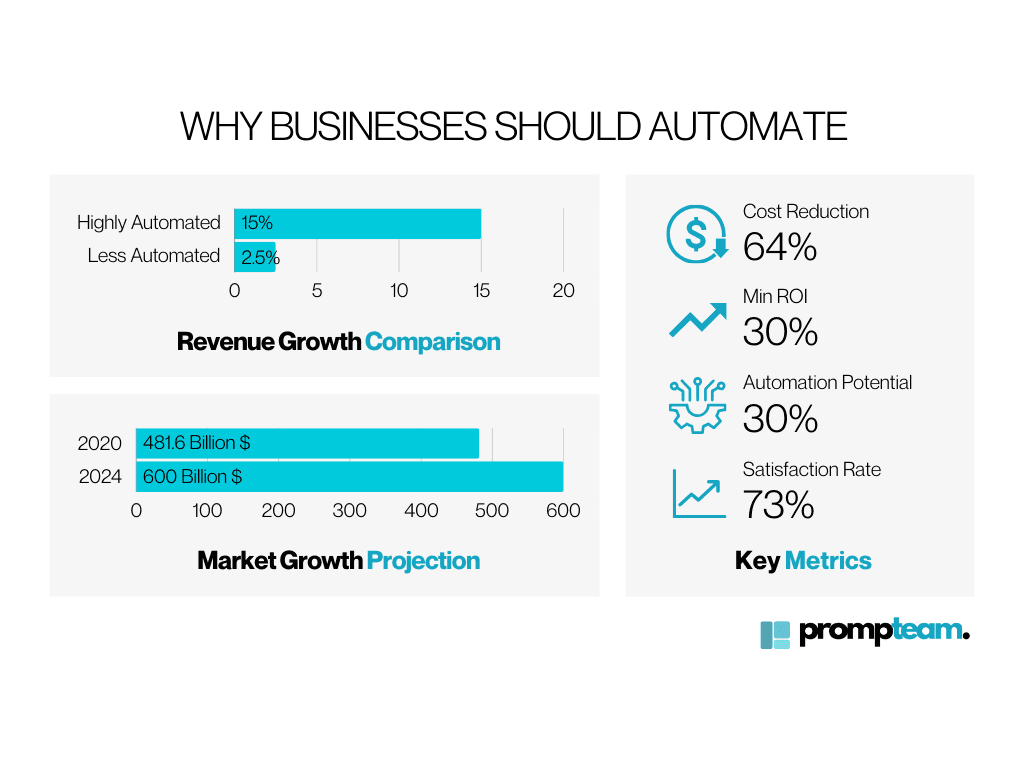
Top Repetitive Tasks To Automate in Businesses
If your business still relies on manual processes for routine tasks, you’re leaving efficiency—and profit—on the table.
Automating repetitive tasks doesn’t just save time—it cuts costs, reduces errors, and frees up your team to focus on higher-value work.
Here are some repetitive tasks that you can automate in your business.
Why is Automation Important in Businesses?
66% of businesses have tested automating their processes in one or more areas, up from 57% in 2018.
This increase shows that more companies are recognizing the benefits of automation for improving efficiency and productivity.

Why Businesses should automate
In fact, the global hyper-automation software market is expected to reach nearly $600 billion by 2024.
In the first year, automation has helped companies cut costs by 24%, with ROI ranging from 30% to 200%. It also saves $140 billion annually by reducing inefficiencies and frees up employees for strategic tasks with a promising 73% satisfaction rate.
Repetitive Tasks to Automate in Businesses
1. Data Entry and Integration
Data entry might seem simple, but it’s one of any business's most boring and mistake-prone tasks. Employees often spend a lot of time entering the same information into different systems, leading to costly errors and wasted time.
Automating this process reduces mistakes, speeds things up, and makes everything run more smoothly. This allows your team to focus on more important tasks that require thinking and problem-solving.
2. Email Management
We all know how overwhelming an inbox full of emails can get. Essential messages get buried under routine ones, and follow-ups pile up. Managing emails manually is time-consuming and can lead to missed or delayed responses.
However, automating your email system helps organize everything so you can respond faster and stay on top of things.
Some options include:
SaneBox- Helps declutter your inbox by filtering out unimportant emails into a separate folder called “SaneLater.” It uses algorithms to analyze email history and prioritize important messages.
Key Features: Email snoozing, reminders, follow-up tracking.
Front- It combines emails, apps, and teammates in one platform, allowing teams to collaborate on email communication effectively.
Key Features: Shared inboxes, internal comments, and integrations with other tools.
Hiver- It is designed for teams using Gmail, enabling them to manage shared inboxes without leaving the Gmail interface.
Key Features: Email assignment, shared labels, and email notes.
3. Expense Reporting
Expense reporting is another task that takes too long and needs to be corrected. Employees submit receipts, and finance teams process reimbursements, but the whole thing can get messy.
The solution? Automate it.
With digital expense systems, you can reduce paperwork, speed up reimbursements, and lower errors.
4. Social Media Scheduling and Posting
Social media is essential for staying connected with your audience, but updating posts regularly can be a huge time-sink.
Automation helps you schedule posts in advance so you can stay active online without constantly being glued to your phone. Scheduling posts ahead also means your content gets posted at the best times for engagement.
5. Report Generation
Creating reports manually is not only time-consuming but also prone to errors. The process often involves sifting through large amounts of data, which can be overwhelming and inefficient. Automating report generation can save your team hours weekly, ensuring your data is accurate and up-to-date.
Tools like PrompTeam.ai understand the context of your conversations and can generate detailed, relevant reports based on the information you're discussing. This means no more manual data entry or tedious report formatting.
6. Customer Support with Chatbots
Handling a lot of customer inquiries can overwhelm even the best support teams. But chatbots can help.
These AI-powered tools can answer routine questions, provide instant responses, and let human agents focus on more complicated issues.
The result? Faster replies, happier customers, and lower costs. Businesses using chatbots or smart FAQ widgets report up to a 30% reduction in customer service costs and better overall response times.
7. Sales Order Processing
Processing sales orders by hand can be slow, lead to mistakes, and cause delays. But automating the order process ensures everything is handled quickly and correctly, no matter where the order comes from.
This improves sales efficiency and reduces errors, leading to a smoother customer experience. Businesses that automate sales orders can see a 20% increase in efficiency, meaning orders are fulfilled faster and customers are happier.
8. HR Processes (Onboarding, Payroll)
HR tasks like onboarding new employees, managing payroll, and conducting performance reviews are critical but can be highly time-consuming and error-prone. This can help new hires get up to speed quickly, payroll is handled accurately, and reviews are completed efficiently.
Tools like PrompTeam.ai can take HR automation a step further through their resume screening tools. This can quickly assess resumes and match candidates to job requirements based on qualifications, experience, and skills.
PrompTeam’s Employee Satisfaction Analyzer also uses data to assess employee satisfaction, providing HR teams with insights to help improve retention and engagement. This means less paperwork, fewer errors, and more time for HR teams.
Conclusion
Automating repetitive tasks is the key to saving time, cutting costs, and letting your team focus on what really matters. The right tools can make a big difference, from managing emails to handling customer support.
Ready to simplify your workflow? Check out Prompteam.ai and see how easy it is to get started!
